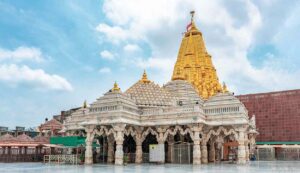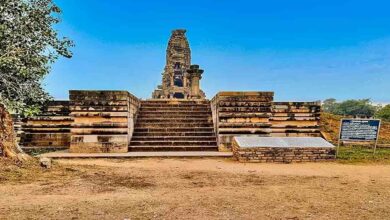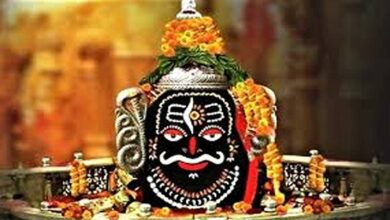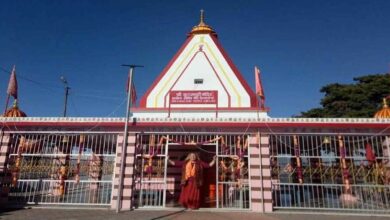Ambaji Temple (Gujarat): Know about the spiritual power and importance of Ambaji temple located in Banaskantha
Ambaji Temple (Gujarat): One of the great Shakti Peethas of India, Ambaji Temple, a sacred temple of Goddess Amba, is held as a valuable treasure in the cultural and religious heritage of Gujarat. This temple holds a distinct character due to its famous spiritual power apart from its historical past and old architecture. However, do you know about the location of Ambaji Temple Banaskantha? Who built this temple and when? What is the mythological background of this Shakti Peeth?

Where is Ambaji Temple in Banaskantha?
Ambaji Temple is a sacred pilgrimage center located in the attractive foothills of the Aravalli mountain range in the Banaskantha district of Gujarat. Located in the town of Ambaji near the Gujarat-Rajasthan border, this holy temple is famous for both its natural beauty and religious significance.
Ambaji Temple has great spiritual significance, as it is considered to be one of the 51 Shakti Peethas, the place where the heart of Goddess Sati fell. Here Maa Ambaji is worshipped in the form of Sriyantra, which is said to be not an idol but a self-manifested idol of the Goddess. This feature makes it different from other Shakti Peethas, which is why thousands of devotees come here to experience the blessings of the Mother.
What is the history of the Banaskantha Ambaji Temple?
The history of Ambaji Temple dates back several centuries; since that time, it has been an important place of devotion to the divine power. This temple was built in honor of the feminine power, which is considered to be the source of life force and the spiritual power of creation according to ancient beliefs.
The legend of the Shakti Peethas of Hindu mythology says that this is the place where the heart of Goddess Sati fell during the Tandava dance of Lord Shiva, when he was carrying her corpse. The vast tradition of Shakti Peethas, which began with the fall of Sati’s severed body parts on the ground, includes this temple as an important component. Ambaji Temple, which is considered incredibly sacred, is an important center of this divine chain.
This temple has been the primary center of faith and devotion of followers for generations. Its grandeur and divinity have constantly increased as a result of many extensions and modifications over time. Even today, thousands of devotees come here to seek the blessings of Goddess Amba and this temple is considered a wonderful heritage not only from a religious point of view but also from a cultural and historical point of view.
What does the architecture of Ambaji Temple of Banaskantha look like?
Gorgeous Hindu Temple Style: One of the best examples of traditional Hindu temple architecture is the Ambaji Temple. Its massive entrance, beautifully carved pillars and majestic tower reaching the skies offer visitors a unique spiritual experience.
Carvings and Sculpture: The temple walls, pillars and ceilings are beautifully carved with images of gods and goddesses from mythology. Apart from enhancing the beauty, this incredible craftsmanship strengthens the faith of the followers.
Unique Sanctum Sanctorum Structure: The sanctum sanctorum of the Ambaji temple is particularly noteworthy as it does not have a traditional idol of the goddess. The spiritual feature of the temple is further enhanced by the installation of a sacred yantra in its place, which is considered a sign of divine power.
Artistic Walls and Ceilings: The walls and ceilings of the temple are adorned with very beautiful artwork. Their sculptures are among the best specimens of ancient Indian art, instilling a sense of sanctity and historicity in the devotees visiting here.
Spiritual and architectural significance: The architecture of this temple makes it valuable from both architectural and religious points of view. For devotees, it is a blend of art and religion, as the shape of the yantra of the goddess, the magnificent carvings and the grand architecture make it stand out from other temples.
What role does the Ambaji Temple of Banaskantha Play?
One of the 51 Shakti Peethas, Ambaji Temple is said to be the place where the heart of Maa Sati fell. This holy place is said to be the primary source of power that energizes the followers.
Events during Navratri: Garba, Bhajan-Kirtan and other cultural programs are organized at Ambaji Temple during Navratri, which take the devotees to a state of emotional frenzy and provide a beautiful feeling of spiritual happiness.
Tantra Sadhana: Since it is believed to be filled with heavenly powers that aid spiritual growth, this temple is an important center for Tantra Sadhana, where Tantrikas practice Mantra Siddhi.
How can I reach Ambaji Temple in Banaskantha?
Abu Road is the nearest railway station to the temple, which is about 20 km from Ambaji Temple. Taxis and transport facilities are easily available from here.
The nearest airport for devotees is Udaipur, which is about 185 km away. You can travel to Ambaji from here by car.
The easiest road route to reach Ambaji Temple is the Ahmedabad-Palanpur Highway. Regular bus services are available from many Gujarati and Rajasthani cities.
What is the admission fee?
| S NO | Details | शुल्क |
| 1 | Free entry for Darshan | No charge |
| 2 | Facility for special prayers | ₹51 to ₹501 |
| 3 | Parking for private vehicles | ₹30 to ₹100 |
FAQs
Q. Where is Ambaji Temple, Banaskantha, located?
Answer: The Ambaji Temple is situated in the town of Ambaji, close to the Rajasthani border, in the Banaskantha district of Gujarat, on the foothills of the Aravalli range.
Q. What qualifies Ambaji Temple as a Shaktipeeth?
Answer: Ambaji Temple is regarded as a particularly important spot in terms of spirituality, as it is one of the 51 Shaktipeeths, where the heart of Goddess Sati fell.
Q. What shape does Ambaji Temple’s Goddess devotion take?
Answer: The Goddess Ambaji is worshipped at this temple as Sriyantra, which is said to be the Goddess’ self-manifested idol, rather than as an idol.
Q. What is the Ambaji Temple’s architectural specialty?
Answer: Grand shikharas, elaborate pillars, magnificent carvings, and legendary sculpture are all features of the temple’s architecture that enhance its majesty and holiness.
Q. What role does Navratri play at Ambaji Temple?
Answer: The temple hosts Garba, Bhajan-Kirtan, and cultural events during Navratri, which gives the devotees a sense of spiritual joy.
Q. Which train station is the closest to Ambaji Temple?
Answer: Abu Road, which is around 20 km from Ambaji Temple, is the closest train station.





